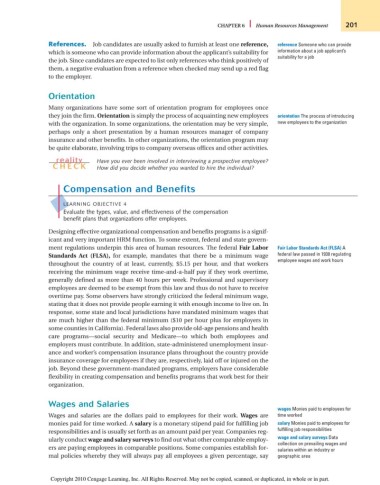Page 227 - Introduction to Business
P. 227
CHAPTER 6 Human Resources Management 201
References. Job candidates are usually asked to furnish at least one reference, reference Someone who can provide
which is someone who can provide information about the applicant’s suitability for information about a job applicant’s
suitability for a job
the job. Since candidates are expected to list only references who think positively of
them, a negative evaluation from a reference when checked may send up a red flag
to the employer.
Orientation
Many organizations have some sort of orientation program for employees once
they join the firm. Orientation is simply the process of acquainting new employees orientation The process of introducing
with the organization. In some organizations, the orientation may be very simple, new employees to the organization
perhaps only a short presentation by a human resources manager of company
insurance and other benefits. In other organizations, the orientation program may
be quite elaborate, involving trips to company overseas offices and other activities.
reality Have you ever been involved in interviewing a prospective employee?
CH ECK How did you decide whether you wanted to hire the individual?
Compensation and Benefits
LEARNING OBJECTIVE 4
Evaluate the types, value, and effectiveness of the compensation
benefit plans that organizations offer employees.
Designing effective organizational compensation and benefits programs is a signif-
icant and very important HRM function. To some extent, federal and state govern-
ment regulations underpin this area of human resources. The federal Fair Labor Fair Labor Standards Act (FLSA) A
Standards Act (FLSA), for example, mandates that there be a minimum wage federal law passed in 1938 regulating
employee wages and work hours
throughout the country of at least, currently, $5.15 per hour, and that workers
receiving the minimum wage receive time-and-a-half pay if they work overtime,
generally defined as more than 40 hours per week. Professional and supervisory
employees are deemed to be exempt from this law and thus do not have to receive
overtime pay. Some observers have strongly criticized the federal minimum wage,
stating that it does not provide people earning it with enough income to live on. In
response, some state and local jurisdictions have mandated minimum wages that
are much higher than the federal minimum ($10 per hour plus for employers in
some counties in California). Federal laws also provide old-age pensions and health
care programs—social security and Medicare—to which both employees and
employers must contribute. In addition, state-administered unemployment insur-
ance and worker’s compensation insurance plans throughout the country provide
insurance coverage for employees if they are, respectively, laid off or injured on the
job. Beyond these government-mandated programs, employers have considerable
flexibility in creating compensation and benefits programs that work best for their
organization.
Wages and Salaries
wages Monies paid to employees for
Wages and salaries are the dollars paid to employees for their work. Wages are time worked
monies paid for time worked. A salary is a monetary stipend paid for fulfilling job salary Monies paid to employees for
responsibilities and is usually set forth as an amount paid per year. Companies reg- fulfilling job responsibilities
ularly conduct wage and salary surveys to find out what other comparable employ- wage and salary surveys Data
collection on prevailing wages and
ers are paying employees in comparable positions. Some companies establish for- salaries within an industry or
mal policies whereby they will always pay all employees a given percentage, say geographic area
Copyright 2010 Cengage Learning, Inc. All Rights Reserved. May not be copied, scanned, or duplicated, in whole or in part.

